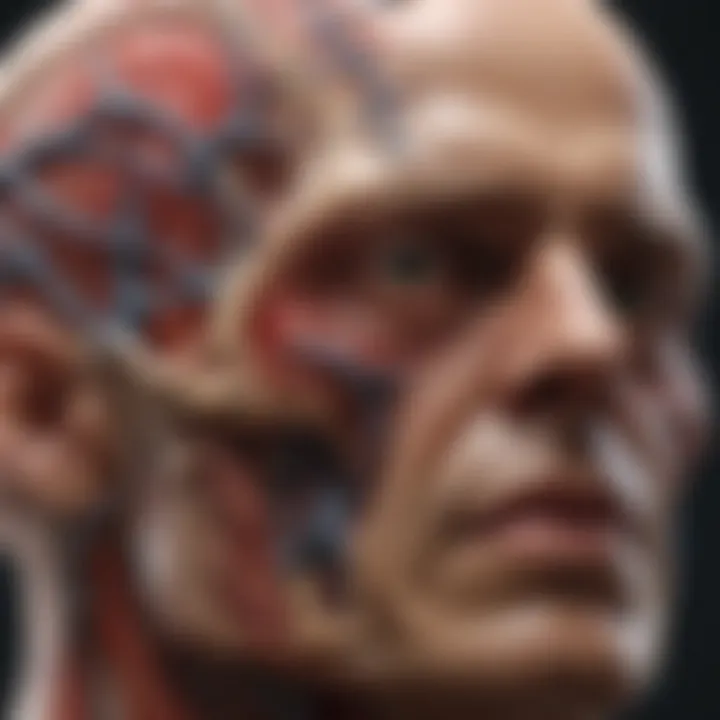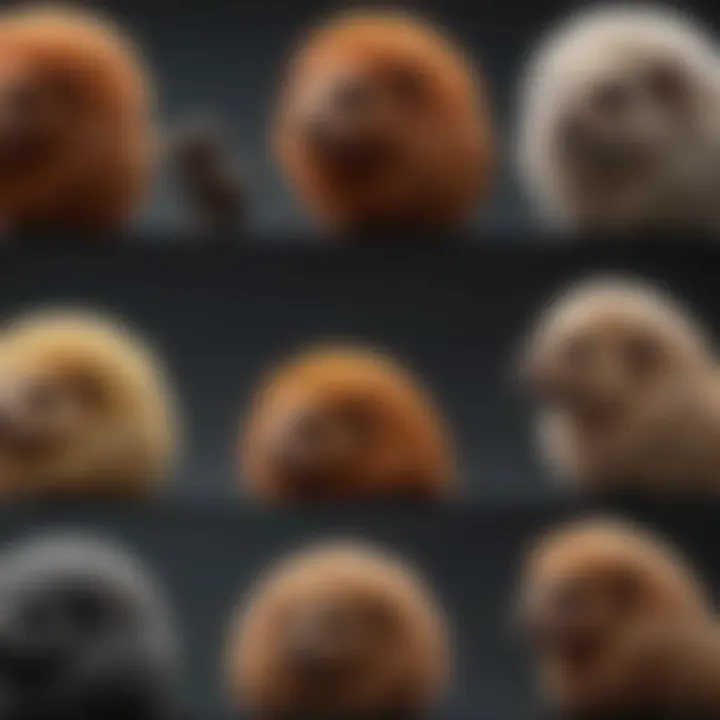Nares: Anatomy, Function, and Evolutionary Impact


Intro
The nares, commonly known as the nostrils, are often overlooked yet play a pivotal role in our everyday lives. They serve as the external gateways to our nasal cavity, impacting how we breathe, smell, and even communicate. To truly appreciate the significance of these structures, one must dive deeper into their anatomy and functionality, as well as their broader implications in the realm of respiratory health.
In a world that increasingly prioritizes understanding the intricacies of our bodies, a comprehensive examination of nares seems not only timely but essential. This article aims to peel back the layers of complexity surrounding nares, looking at their structural features, physiological roles, and the challenges they may face in the context of various disorders. As we venture through this detailed exploration, we will also uncover how different species adapt their nasal structures to cope with diverse environmental conditions, underscoring the evolutionary significance of nares.
As well as catering to students and researchers, this investigation targets a broader audience eager to grasp the foundational aspects of respiratory health. Armed with a wealth of information, readers will leave with a profound understanding of the nares—far beyond their mere aesthetic appearance.
Prelims to Nares
Understanding the nares is fundamental for both human biology and medicine. Often overlooked, these external openings of the nasal cavity hold significant roles that extend beyond mere respiration. They serve as an essential gateway for air, impacting not just our ability to breathe, but also how we perceive our surroundings through smell. This article dives into the structural intricacies and functional importance of the nares, bringing to light their relevance in both health and disease.
Definition and Location
Nares, simply stated, are the nostrils we can easily see and touch on the exterior of our nose. Their anatomical placement is strategic, positioned above the mouth and leading directly into the nasal cavity. This placement allows for efficient airflow and offers rapid access to the olfactory epithelium, which is responsible for our sense of smell. The nares are typically divided into two distinct openings — the right and left nares — separated by the nasal septum, which plays an important role in balancing airflow during respiration.
Additionally, each naris is encircled by various structures, including cartilage, skin, and hairs. These elements work cooperatively to filter out particles and pathogens, serving to protect the more delicate structures that lie deeper within.
To summarize, the nares are not just passive structures; they are dynamic interfaces, crucial for day-to-day functioning involving breathing and smelling.
Historical Context of Nares Study
The journey into understanding nares dates back centuries, leading through various stages of scientific inquiry. Ancient civilisations, like those in Egypt and Greece, held philosophical thoughts about the functions of the nose but lacked the anatomical precision we have today. It wasn’t until the Renaissance, with advances in anatomy and dissection practices, that the scientific community could perform detailed investigations of nasal structures.
In the 19th century, as medical science gained momentum, researchers began exploring the nares through a pathological lens. They started linking the structure and condition of the nares to respiratory diseases, and this marked a significant turning point in our comprehension.
Now, studies on nares have integrated complex imaging technologies and molecular biology, expanding our knowledge base. Recognition of the nares as vital to respiratory health continues to grow, guiding contemporary research and influencing treatment methodologies.
As we can see, the history surrounding the nares is rich and multifaceted. Each step has contributed to the deeper understanding we enjoy today; appreciating this lineage is crucial when examining contemporary issues related to nasal health.
Anatomical Features of Nares
Understanding the anatomical features of nares is crucial for comprehending their roles in health and disease. These external openings are more than just pathways for air; they are intricately designed structures that exhibit a unique composition, enabling various functions critical to survival. This section will delve into the structural aspects, the importance of the underlying support systems, and the specialized cells that maintain nasal health.
Structure and Composition
The nares, commonly referred to as nostrils, are the visible parts of the nasal cavity that lead to the respiratory system. Their shape and size can vary significantly among individuals, influenced by genetic and environmental factors. Each naris comprises several key components:
- Nasal Cartilage: The flexible cartilaginous structure forming the tip of the nose, particularly important for maintaining shape while allowing minor movements.
- Skin and Hair Follicles: Protecting the inner airway, the skin layer contains fine hairs (vibrissae) that trap larger particles entering through the nares.
- Philtrum: The groove running from the nose to the upper lip helps define the upper lip region, contributing to the aesthetic and functional aspects of the nares.
These elements work in concert to create an efficient entry point for air. Furthermore, the structure of the nostrils allows for differentiation in airflow, helping to optimize the respiratory process. In short, the nares are not merely holes but a complex arrangement that promotes effective breathing and filtering of air.
Role of Cartilage and Bone
The architecture of the nares is underpinned by both cartilage and bone, which play different yet complementary roles. The cartilaginous framework provides elasticity while ensuring stability. This is essential for allowing movement without compromising overall integrity.
Bone, on the other hand, provides rigid support. The nasal bones, located just above the cartilage, give shape to the middle of the face and protect deeper structures. An interesting aspect of nasal anatomy is how the facial bone structure can influence airflow and sound resonance, demonstrating the interconnectedness of nares with other anatomical features.
Mucosal Membranes and Cilia
Within the nares, the nasal mucosa serves a critical purpose. Lined with ciliated epithelium, the mucosal membrane is not just a passive layer; it actively participates in conditioning the air we breathe.
- Ciliated Cells: These tiny hair-like structures move in a coordinated fashion to push trapped particles and mucous toward the throat, where they can be swallowed or expelled. This plays a vital role in maintaining respiratory health and preventing infections.
- Goblet Cells: Specialized cells within the mucosal layer produce mucus, which traps dust, allergens, and pathogens entering through the nares.
This combination of features creates a finely tuned filtration and defense system that works tirelessly to protect the respiratory passages from harm. Importantly, the condition of the mucosal membranes can significantly affect overall nasal function, thus highlighting the need for awareness of nasal health in both clinical and everyday contexts.
"The nares serve as a sophisticated interface between the external environment and the deeper respiratory system, intricately designed for efficiency and protection."


In summary, the anatomical features of the nares are fascinating. From structural components like cartilage and bone to functional elements such as cilia and mucosal membranes, every aspect is geared towards supporting respiratory health. Understanding these features is foundational for grasping the broader implications of nares in human health and biology.
Functional Aspects of Nares
The nares play a pivotal role in multiple physiological processes that contribute to overall health. Understanding their functional aspects helps to illuminate how these structures impact not just respiratory efficiency but also our senses and immune defenses. Each subtle aspect, from the way air flows through to the involvement in our sense of smell, reveals the complexity of this seemingly simple structure.
Respiratory Functionality
Respiration, the act of breathing, is mainly facilitated by the nares. When we inhale, the nares serve as the primary entry point for air into the nasal cavity. The design of the nares, being somewhat flexible and structurally complex, allows them to regulate airflow. The narrow passage can help control the volume of air drawn in which, in turn, aids in effective gas exchange in the lungs.
Moreover, the nares are lined with mucosal membranes that trap dust, pollutants, and microorganisms in the air we breathe. By doing so, they not only ensure that cleaner air reaches the lungs but also help prevent respiratory infections. The natural secretion of mucus within the nares serves this protective function efficiently, indicating a well-developed system designed for optimal respiratory performance.
Beyond just these basic functions, the role of nares in thermoregulating inhaled air is significant too. The nares help to warm or cool the air before it reaches the delicate tissues of the lungs. This adaptation is especially essential in extreme climates. For instance, in cold environments, the nares work to add warmth to the frigid air, protecting the lungs from shock.
Role in Olfaction
The connection between nares and the olfactory system is not merely incidental. The nares are integral in the perception of smells, with their structure allowing odorous molecules to access the olfactory receptors situated high within the nasal cavity. Upon inhaling, aromatic particles are guided through the nares into olfactory epithelium, where they interact with sensory receptors, initiating the complex process of smell perception.
In this way, the nares are not just gateways for air but are also pathways for enriching our sensory experiences. A great example of this is in culinary contexts—our nares permit us to experience flavor not only by tasting but also by smelling food, engaging multiple aspects of our sensory apparatus. On a more biological level, the ability to detect scents can have evolutionary implications—being able to smell food or potential danger played a crucial role in early human survival.
Protection Against Pathogens
Another vital function of nares is their ability to act as a barrier against pathogens. The nares not only filter out harmful particles but also initiate immune responses through various means, starting at the surface. Cilia—tiny hair-like structures lining the nares—play a crucial role. These cilia move in a coordinated manner to sweep mucus, along with trapped pathogens, towards the throat, where they can be swallowed or expelled.
Key elements of nasal protection include:
- Mucus Production: The moisture from mucus traps pathogens and particulates.
- Ciliary Action: Maintains a cleaning mechanism for the nasal passages.
- Local Immune Response: The presence of immune cells in the nares enables an immediate response to infections.
"The nares act as the first line of defense within the respiratory system, safeguarding our health by filtering out undesirable invaders."
Thus, while the nares may seem like simple external openings, they encapsulate a wealth of functional significance. Their roles in respiration, sensitivity to scents, and defense against pathogens highlight the intricate balance of biological processes that maintain human health.
The Role of Nares in Human Health
Understanding the role of nares in human health is crucial, especially because these structures are often overlooked despite their significant influence on our well-being. The nares, being our first line of defense against the outside world, play a multifaceted role in maintaining overall health, from facilitating respiration to acting as a gateway for scent perception. Their importance cannot be understated, especially considering how intertwined they are with various physiological processes that impact daily life.
Proper nasal function helps filter, warm, and humidify the air we breathe, which is vital for optimal respiratory function. Without the nares effectively performing these roles, the respiratory system is at risk of various complications.
Common Disorders Related to Nares
A variety of disorders can arise from issues with the nares. These disorders may manifest as discomfort, difficulty in breathing, or more severe health concerns.
- Nasal Congestion: Often caused by allergies, infections, or structural abnormalities, nasal congestion occurs when the tissues lining the nares become swollen. This reduces airflow and can make simple tasks, like breathing or sleeping, a chore.
- Rhinitis: Inflammation of the nasal lining is termed rhinitis and can be classified into allergic and non-allergic types. Each can cause frustrating symptoms including sneezing, itching, and a runny nose.
- Sinusitis: Inflammation or swelling of the sinus lining, sinusitis can result from untreated nasal congestion, leading to significant discomfort and pain in the face and forehead region.
- Nasal Polyps: These non-cancerous growths can develop in the nasal passages and are often linked with asthma or allergies. They can obstruct airflow and result in a decrease in quality of life.
It's evident that these disorders not only affect the nares but also originate from them. When the nares are not functioning optimally, the risk of developing these conditions increases significantly.
Impact of Allergies and Infections
Allergies and infections pose significant challenges to nasal health.
- Allergic Reactions: Allergens like pollen, dust mites, and pet dander can trigger an overreaction of the immune system, leading to inflammation of the nares. This inflammation restricts airflow and can worsen symptoms like congestion and mucus production. The result? A life disrupted by incessant sneezing and nasal irritation.
- Viral Infections: The common cold and other viral infections often target the nasopharyngeal region. Swelling and mucus production from these infections can exacerbate pre-existing nasal issues and lead to further complications like sinusitis.
- Bacterial Infections: Following a viral infection, secondary bacterial infections may occur, causing additional discomfort and compounding health risks. For example, once the normal defense mechanisms are down, bacteria can take hold and worsen existing nasal issues.
The interplay of allergies and infections highlights the nares' crucial role as protective barriers.
"Nares are not just external structures; they embody the delicate balance between health and disease."
Evolutionary Adaptations of Nares


The adaptability of nares across various species represents a remarkable aspect of evolutionary biology. This adaptability is not just about survival; it reflects how organisms evolve in tandem with their environments and lifestyles. By examining the differences and similarities of nasal structures in various species, one gets a clear picture of how nares have been fine-tuned to meet specific needs, particularly relating to breathing, olfaction, and even social signaling.
Comparative Anatomy Across Species
When we talk about nares, the differences between species become strikingly apparent. For instance, the nares of mammals like dogs and cats are larger and more prominent compared to those of humans. This structural difference facilitates their superior olfactory abilities. Dogs possess about 300 million olfactory receptors, compared to humans’ mere 5 to 6 million. The variation in size and configuration illustrates how these animals have adapted their nares for a distinct primary function—smell—to navigate their environments effectively.
In birds, nares can often be found positioned in ways that correspond to their feeding strategies. For example, in ducks, the nares are located at the base of the bill, permitting them to filter food from water, enabling a unique adaptation that supports their diet.
In contrast, aquatic animals such as whales exhibit a different adaptation with a blowhole instead of traditional nares. This adaptation allows them to breathe efficiently while swimming, emerging only momentarily to exchange gases.
Thus, nares across species provide a fascinating glimpse into evolutionary pressures and ecological niches that shape anatomical design.
Environmental Adaptations and Their Significance
The environment also plays a pivotal role in shaping the nares of different species. For instance, species inhabiting arid regions, such as certain desert rodents, have developed elongated nares. This feature serves two purposes; it helps to warm the inhaled air and extract moisture from exhaled air, which is a survival mechanism in harsh conditions. Similarly, polar bears have evolved nares that are structured to minimize heat loss while breathing in frigid climates.
In marine environments, some fish species have developed specialized nostrils to aid in navigation and foraging in dark or murky waters.
These variations indicate not just survival but the nuances of behavioral adaptations vital for species continuity. It’s clear that the nares play a significant role far beyond basic respiration; they are integrated into the very fabric of how a species interacts with its environment. As such, understanding these adaptations opens windows into the evolutionary pathways that have shaped the diversity of life on our planet.
"The evolutionary journey of nares explains how organisms adapt in varied habitats to ultimately thrive within their ecological settings."
In summary, the evolutionary adaptations of nares underscore a complex interplay between an organism's physiological structures and its ecological demands. The examination of these anatomical features across species allows a deeper understanding of both historical evolution and present-day survival strategies.
Cultural Perceptions and Literary References
The consideration of nares extends far beyond the realm of biology or medicine. Their cultural significance and representation in literature and art reveal much about societal values and human experiences. The nares, often overlooked, serve as a powerful symbol in diverse contexts, embodying both physiological function and rich metaphorical meanings. An exploration into this aspect enhances our understanding of how deeply human anatomy intertwines with culture, illuminating views on health, beauty, and even identity.
Representation in Literature and Art
In various literary works, nares often serve as a focal point for character descriptions, offering insight into emotional states or social conditions. From ancient texts to modern narratives, they have been used to signal everything from vitality to decay. For instance, in literature, an author may describe a character's nares flaring in agitation or excitement, representing a physiological response tied to emotional truth. This imagery evokes a visceral understanding of the character's predicament.
Art has similarly reflected cultural attitudes towards nasality. Renowned paintings, sculptures, and even contemporary installations often highlight the nose and nares as symbols of beauty and individuality. Take the works of the Italian Renaissance for example; here, the human form is celebrated, and nares become part of the idealized visage portrayed in art, echoing the societal beauty standards of the time.
In modern art, the artistic interpretations of nares can challenge conventional beauty norms, prompting discussions about identity and body politics. Artists may portray exaggerated or abstract representations of nares to interrogate notions of desirability and health, thus providing a platform for dialogue.
Additionally, various cultures have attributed meanings to nasal features. In some societies, a wider nose might be seen as a sign of beauty or strength, while narrow nares might suggest delicateness. These differing perspectives highlight the cultural relativity surrounding physical traits and remind us how perception molds health and identity in nuanced ways.
Social Implications of Nasal Health
Nasal health is often perceived through a dual lens of physical wellness and social consequence. Culturally, the state of one's nares can affect social interactions and self-perception. Disorders like sinusitis or rhinitis not only have practical health consequences but can also lead to social stigma. For example, individuals who frequently experience nasal congestion may feel embarrassed in social situations, avoiding gatherings or interactions that bring attention to their discomfort.
Moreover, in many cultures, a clear and functional nose symbolizes vitality and attractiveness. The social implications of nasal issues stretch into socializing norms, dating, and even professional environments, where a healthy appearance can be equated with competence.
On another note, the concept of "nasal aesthetics" has emerged in society, impacting trends in cosmetic and medical procedures aimed at altering the appearance of the nose. This predicament emphasizes the intersection between health, beauty standards, and social pressures, prompting individuals to consider their nasal features against societal expectations. The narrative around nares thus becomes not only about functionality but also about the implications of appearance in social contexts, shedding light on how health can intertwine with cultural values.
"The nose is the bridge to the soul, but whose soul carries the burden of public opinion?"
Therefore, understanding nares requires not only biological insight but also awareness of the cultural lens through which they are viewed. This intersection highlights that nares are not just openings for breathing; they are significant markers in the fabric of human interaction and self-identity.
Educational Perspectives on Nares
Understanding the nares transcends mere anatomical study; it opens avenues for deeper comprehension in various biological domains. The nares, pivotal in respiration and olfaction, serve as a gateway not just into the nasal cavity but also into broader themes in human health and evolution. Incorporating the study of nares into education equips students and professionals alike with insights that can significantly enrich their understanding of anatomy, physiology, and pathology.
The role of nares in education is multi-faceted. In a classroom setting, the nares can help bridge topics such as respiratory biology, comparative anatomy, and evolutionary biology. Educators can leverage the nares to illustrate complex concepts in a tangible manner, encouraging students to engage, ask questions, and foster holistic learning.
Incorporating Nares into Biological Education


Integrating the nares into biological curricula presents educators with opportunities to present real-world applications. For instance, when discussing the respiratory system, nares can be spotlighted as they play a crucial role in filtering air, regulating airflow, and providing pathways for olfactory signals.
Here are some effective ways to incorporate nares into biological education:
- Lectures and Visual Aids: Employ diagrams or models that highlight the structure and positioning of nares in various species.
- Hands-On Activities: Use simple experiments demonstrating airflow, such as blowing through a straw to mimic nasal respiration.
- Field Studies: Encourage students to observe the nares and nasal structures of different mammals to appreciate evolutionary biodiversity.
- Comparative Analyses: Explore how different species adapt their nares for specific environmental challenges, fostering critical thinking and analytical skills.
Such methods not only make the learning process interactive but also instill a sense of inquiry about anatomical structure and its function.
Resources for Further Study
For those eager to explore the intricacies of nares further, a variety of resources exist. Here’s a list of recommended study materials:
- Books: "Human Anatomy and Physiology" by Elaine N. Marieb provides fundamental insights into the respiratory system, including the nares.
- Online Journals: Articles published in journals like the American Journal of Rhinology & Allergy offer updated research on nasal physiology and pathology.
- Web Resources:
- Wikipedia – A comprehensive overview of nasal anatomy and functions.
- Britannica – For curated articles detailing the anatomical and functional aspects of the nose.
- Reddit – Engage in discussions and ask queries related to anatomical studies.
These resources not only facilitate deeper understanding for students and educators but also encourage ongoing exploration into this crucial aspect of biology.
"By drilling down into the nuances of nares, we uncover not just a biological structure but also a rich interplay between form, function, and health across species."
As we navigate through discussions surrounding the nares, we pave the way for a future of holistic understanding in biological studies, making it imperative for educators to guide and illuminate this crucial topic.
Future Research Directions on Nares
The exploration of nares and their functions has taken on greater significance in recent years, with a growing recognition of their role in human health and disease. Future research directions on nares are not only essential for advancing our understanding of respiratory physiology but also for paving the way for novel therapeutic applications. As scientists dive deeper into this subject, several key areas show promise for investigation, providing benefits that could extend from clinical improvements to environmental adaptations.
Emerging Technologies in Nasal Research
Innovations in technology are reshaping our approach to studying nares, leading to dynamic methods and tools that enable more intricate analyses. One such area is the utilization of imaging techniques, which allow for non-invasive observation of nasal structures and functions. Techniques such as MRI (Magnetic Resonance Imaging) and CT (Computed Tomography) scans can give clear visuals of the nasal cavity, further enlightening our understanding of nasal airflow and obstruction.
- 3D Bioprinting offers another frontier, potentially allowing researchers to create living nasal tissue constructs. This could have implications in grafting for surgical reconstructions and tackling disorders linked to nasal structure.
- Additionally, advancements in omic technologies, like genomics and proteomics, could aid in pinpointing genetic variations influencing nasal health, thus opening doors to personalized medicine approaches.
This wave of technology doesn't just enhance knowledge; it prepares the ground for a shift in how treatments might be designed and delivered, taking into account a more nuanced view of how nares operate under various conditions.
Potential Paradigms in Respiratory Medicine
Nares, as the body's first line of defense in the respiratory system, are intricately connected to an array of health issues. Future research directions could lead to new paradigms in respiratory medicine, potentially transforming management strategies for allergic and infectious diseases. By further understanding the link between nasal health and overall respiratory function, clinicians could develop targeted interventions.
- For example, insights gleaned from research into the microbiome of the nasal cavity might illustrate how certain bacteria play roles in maintaining a healthy nasal environment. The pathogenic potential of these organisms could lead to the development of biotherapeutics that restore balance in cases of dysbiosis.
- Moreover, understanding the neuroanatomy of nasal pathways could revolutionize approaches to treating anosmia or augmented conditions resulting from sinusitis, targeting therapies that focus on sensory functions in-depth.
The information gathered from nasopharyngeal studies could help not only in preventive medicine but also deepen our strategies for early diagnosis, improving outcomes in respiratory diseases overall.
As we venture into the future of nasopharyngeal research, the potential to bridge gaps in our understanding of these structures promises to enhance medical practice and understanding of respiratory phenomena.
In summary, focusing on the future of nares research underscores an evolving perspective that integrates technology, biology, and therapeutic applications. This domain holds the potential for life-altering insights, shaping how we perceive and manage nasal and broader respiratory health.
Closure
The examination of nares, the gateways to our nasal cavity, brings to light their essential roles in human biology and health. This article has outlined key elements, including the structure, functionality, and their implications for respiratory health. By deconstructing the anatomy of nares, we see how their composition is not merely functional but also crucial for our overall well-being.
Summary of Key Insights
Throughout this exploration, several critical insights emerge:
- Anatomical Significance: The structure of nares, composed of delicate cartilage and bone, plays a vital role in facilitating airflow while protecting against external elements.
- Olfactory Functions: They are not just airways; nares contribute significantly to our sense of smell, linking aromas with memories and experiences.
- Health Implications: Disorders such as sinusitis can often stem from issues in the nares, highlighting the need for proper care and attention to nasal health.
- Evolutionary Perspective: The adaptability of nares across species underscores their importance in various environments, demonstrating a fascinating aspect of evolution.
"Understanding the nuances of nares is not just a medical exercise; it's a window into the intricate working of human biology."
Final Thoughts on the Importance of Nares
In essence, the nares are far more than mere openings; they are intricate structures essential for life. They enable respiration, facilitate our connection to the world through smell, and act as barriers against pathogens. As such, recognizing their importance leads to better health practices and informed approaches in the field of respiratory medicine. The depth of research on nares assists not only in addressing common health issues but also in appreciating the evolutionary marvels of the human body.
In a world where health is paramount, understanding the nares contributes to a comprehensive view of our biology. The study of nares holds promise for medical advancements and ensures we remain attuned to the signals our body sends us through this unassuming yet vital feature. Care for your nares, and they’ll take good care of you.



